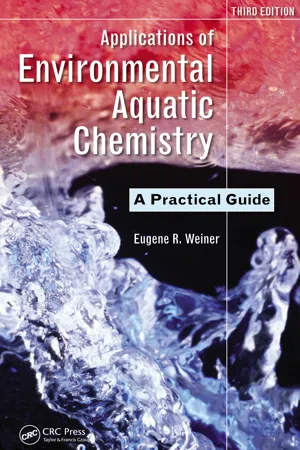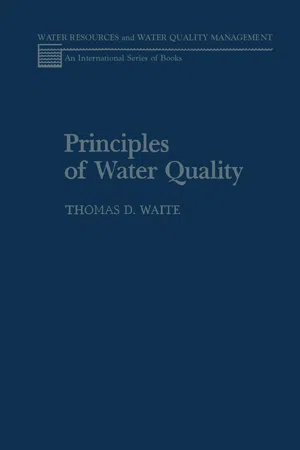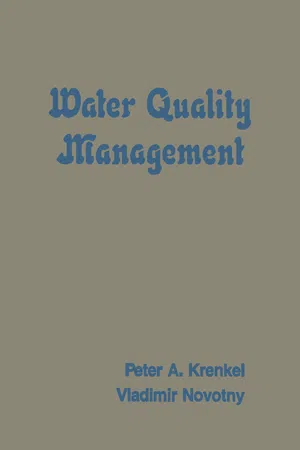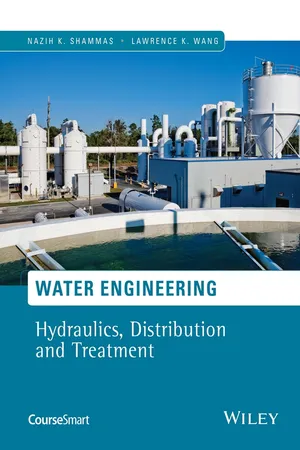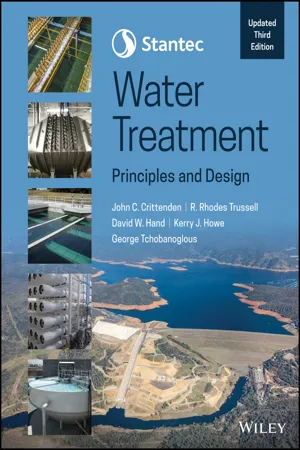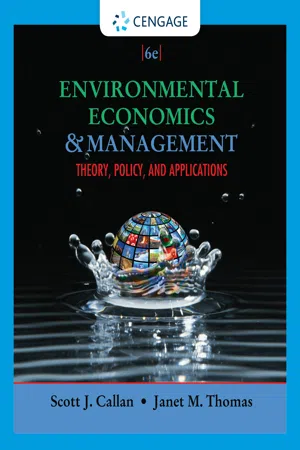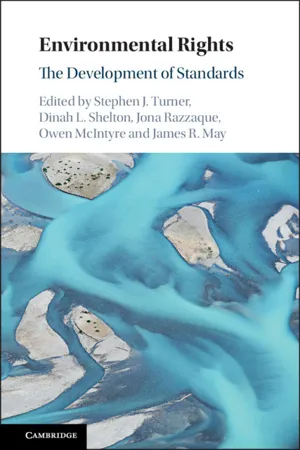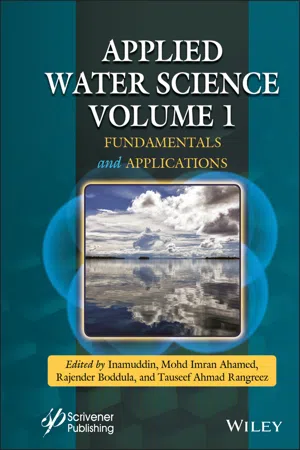Law
Water Quality Standards
Water quality standards are regulations that establish the acceptable levels of various contaminants in water bodies to protect human health and the environment. These standards are set by government agencies and serve as the basis for water quality monitoring and enforcement efforts. Compliance with these standards is crucial for ensuring safe and clean water for public use.
Written by Perlego with AI-assistance
Related key terms
1 of 5
9 Key excerpts on "Water Quality Standards"
- eBook - PDF
Applications of Environmental Aquatic Chemistry
A Practical Guide, Third Edition
- Eugene R. Weiner(Author)
- 2012(Publication Date)
- CRC Press(Publisher)
1 1 Water Quality 1.1 DEFINING ENVIRONMENTAL WATER QUALITY Water quality means different things to different people, depending on their goals for the water. A chemist in a laboratory will regard high-quality laboratory water as water free from chemical impurities or suspended solids. High-quality environ-mental water has different criteria. The same chemist on a wilderness backpack trip might identify high-quality water as water in a pristine environment unaltered by human activity. If the chemist is also a fisherman, she or he might regard high-quality water as a good habitat for fish and other aquatic organisms. A farmer prefers water with low sodium or other dissolved salts that may degrade the soil or be toxic to crops, but may appreciate moderate levels of nutrients such as nitrogen and phos-phorus. A drinking water treatment plant manager will define high-quality water as water with a minimum amount of substances that have to be removed or treated to produce safe and palatable drinking water. A broad view of high-quality water will take into consideration its suitability for particular uses. The U.S. Congress recognized this when it enacted the Federal Water Pollution Control Act Amendments of 1972, Public Law 92500, also known as the Clean Water Act (CWA), where it is stated, “The objective of this act is to restore and maintain the chemical, physical, and biological integrity of the Nation’s waters.” In the law, water quality is a measure of its suitability for particular designated uses. The objective of this act is to restore and maintain the chemical, physical, and biological integrity of the Nation’s waters. Federal Water Pollution Control Act Amendments of 1972, Public Law 92500 (Clean Water Act) ( Photo courtesy of Gary Witt ) - eBook - PDF
- Thomas Waite(Author)
- 2012(Publication Date)
- Academic Press(Publisher)
* Ε, effective date of rules and regulations. 250 1 0 Water Quality Standards and Management Approaches United States since the standards have been enforced. As new compounds, especially toxic industrial compounds, are isolated from public water sup-plies, new standards have to be created. Therefore, the establishment of standards is a dynamic phenomenon, changing through the years. Standards established for drinking water quality are perhaps the easiest to set. This is because estimates of daily water intake and medical studies relating the effects of certain contaminants to dosage are easy to correlate. Water Quality Standards for uses other than drinking are more difficult to establish. In such cases a factor beyond the direct consumption of water must be established, and this problem will be exemplified in the following sections. B. Recreational Water Quality Standards Society now demands that water systems, especially surface waters, be free from hazardous compounds and disease-causing organisms. In addition, surface water quality must be maintained at an acceptable level for body contact as well as being maintained at a level sufficient for effective drinking water treatment. Standards must therefore be established to protect surface waters from degradation. The concern for maintaining high-quality re-ceiving waters means that unit processes must be included for the treatment of waste streams. The treatment of wastewater is very expensive, and therefore reasonable standards must be set that take into account the degree of treatment required. These standards must protect the desired biological system of the receiving waters and make them safe for human contact. Perhaps the most important recreational use of water, with respect to setting standards on quality, is swimming. Swimming involves direct body contact and therefore the greatest chance of contamination from pollutants among recreational uses. - eBook - PDF
- Peter Krenkel(Author)
- 2012(Publication Date)
- Academic Press(Publisher)
3 Physical and Chemical Parameters of Water Quality INTRODUCTION The term water quality is not a new concept. Ancient British Common Law, from which the riparian water rights were derived, stated that the user of water was not entitled to diminish it in quality (McGauhey, 1968). However, the question as to what constituted quality was neither posed nor answered. Even at the beginning of this century, water quality evaluation relied more or less on subjective observations rather than on scientific measurements. Water quality was expressed in terms such as fresh, dirty, faulty, and potable. Only water used for a public water supply was analyzed by early chemical and bacte-riological methods in order to determine its safety for human consump-tion. Recent developments in water quality surveillance methods and con-sequent concern with the protection of human health and the aquatic envi-ronment have broadened the qualification and quantification of water quality. It has been only in the past few decades that water quality engineering and science have begun to develop from an art to a science. New wastewater treatment methods and the discovery and evaluation of new harmful water contaminants and pollutants have stimulated research 46 Classification of Pollutants 47 activities seeking new and improved methods of water quality analysis. Increased emphasis has also been placed on the removal of secondary pollutants such as nutrients or refractory organics and on water reuse. There is no way to define water quality precisely. It must be understood that the quantification of water quality may have a different meaning to an aquatic scientist concerned with aquatic life, a farmer concerned with irri-gation, or a public health official concerned with the protection of human health. In each case, a different picture of water quality can be developed based on the indicators and criteria used for a particular evaluation. - eBook - ePub
Water Engineering
Hydraulics, Distribution and Treatment
- Nazih K. Shammas, Lawrence K. Wang(Authors)
- 2015(Publication Date)
- Wiley(Publisher)
Chapter 10 Water Quality Characteristics and Drinking Water Standards10.1 OBJECTIVES OF WATER-QUALITY MANAGEMENT
Water-quality management is the central theme around which revolve prescriptions for the exploitation, preservation, and reclamation of those properties of water-–physical, chemical, and biological—that are responsible for its extraordinary importance in urban and industrial societies. Within the use cycle of water in dwellings and industries, water-quality management places upon organized communities the obligation to seek out waters of suitable fitness. Within the waste cycle it obliges cities, towns, and industries to send back to the common water resource the spent waters or wastewater effluents of acceptable quality. Assigned to water-quality management thereby is a dual yet essentially unitary responsibility for both water supply and wastewater disposal that can prosper only when quality management establishes and honors reasonable and common objectives and necessary standards.At one end of the quality spectrum of water lie objectives and standards for safe and palatable drinking waters; at the other end are quality requirements for spent waters or wastewater effluents to be introduced into receiving bodies of water or to be disposed of in other ways. Between the two, there are full water quality criteria for bathing, fishing, shellfish harvesting, and irrigation, and for industrial waters of many kinds. They, too, are of concern to this chapter.Water-quality management, as part of water-resource management, shares a need for public and technological support that is normally available only in a well-disciplined and industrially mature society. In furtherance of water quality control, moreover, there must be adequate information not only on the nature and capacity of natural sources of water but also on their physical, chemical, and biological quality. Within the wider meaning of water-quality management, finally, there must be an understanding by engineers of the common properties of the many kinds of water on the earth: of brooks and rivers, of lakes and oceans, and of waters welling from the ground and falling from the sky (Fig. 10.1 - eBook - PDF
Water Pollution Control
A Guide to the Use of Water Quality Management Principles
- Richard Helmer, Ivanildo Hespanhol(Authors)
- 2017(Publication Date)
- CRC Press(Publisher)
Water quality criteria often serve as a baseline for establishing water quality objectives in conjunction with information on water uses and site- specific factors (see Table 2.1). Water quality objectives aim at supporting and protecting designated uses of freshwater, i.e. its use for drinking-water supply, livestock watering, irrigation, fisheries, recreation or other purposes, while supporting and maintaining aquatic life and/or the functioning of aquatic ecosystems. The establishment of water quality objectives is not a scientific task but rather a political process that requires a critical assessment of national priorities. Such an assessment is based on economic considera-tions, present and future water uses, forecasts for industrial progress and for the development of agriculture, and many other socio-economic factors (UNESCO/WHO, 1978; UNECE, 1993, 1995). Such analyses have been carried out in the catchment areas of national waters (such as the Ganga river Water quality requirements 15 basin) and in the catchment areas of transboundary waters (such as the Rhine, Mekong and Niger rivers). General guidance for developing water quality objectives is given in the Convention on the Protection and Use o f Trans-boundary Watercourses and International Lakes (UNECE, 1992) and other relevant documents. W ater quality objectives are being developed in many countries by water authorities in co-operation with other relevant institutions in order to set threshold values for water quality that should be maintained or achieved within a certain time period. Water quality objectives provide the basis for pollution control regulations and for carrying out specific measures for the prevention, control or reduction of water pollution and other adverse impacts on aquatic ecosystems. In some countries, water quality objectives play the role of a regulatory instrument or even become legally binding. - eBook - PDF
Stantec's Water Treatment
Principles and Design
- John C. Crittenden, R. Rhodes Trussell, David W. Hand, Kerry J. Howe, George Tchobanoglous(Authors)
- 2022(Publication Date)
- Wiley(Publisher)
These include standards for individual countries or groups of countries. The WHO has been at the forefront of developing standards. The WHO standards, known as the Guidelines for Drinking Water Quality (WHO, 1993, 2006), are meant for guidance only and are recommendations, not mandatory requirements. However, the WHO stan- dards have been adopted in whole or in part by a number of countries as a basis of formulation for national standards. The WHO guidelines contain recommendations, health-based standards, monitoring, measurement, and removal for microbial quality and waterborne pathogens, chemical constit- uents, radionuclides, and aesthetic aspects. The continued process of water quality regulation is expected to produce additional standards in the future, especially as new compounds are being developed and identified continually. As the U.S. EPA continues to work toward protection of public health, it is expected that standards will be set or revised for more constituents as well as the individual processes and the distribution systems. Improved methods for risk assessment, analysis, and removal of drinking water constituents will also contribute to regulatory activity in the future. In addition, the U.S. EPA released nine white papers on potential public health risks associated with various distribution system State Standards and Regulations International Standards and Regulations Focus of Future Standards and Regulations 189 4-4 Overview of Methods Used to Treat Water issues in 2002 covering the following topics: (1) intrusion, (2) crossconnec- tion control, (3) aging infrastructure and corrosion, (4) permeation and leaching, (5) nitrification, (6) biofilms/microbial growth, (7) covered storage, (8) decay in water quality over time, and (9) new and repaired water mains. 4-4 Overview of Methods Used to Treat Water A variety of methods have been developed and new methods are being developed for the treatment of water. - eBook - PDF
Environmental Economics and Management
Theory, Policy, and Applications
- Scott Callan, Janet Thomas(Authors)
- 2012(Publication Date)
- Cengage Learning EMEA(Publisher)
We then focus on policy goals under the Clean Water Act and how standards are used to define water quality. A two- part policy analysis follows. The first is an evaluation of the standard-setting process. The second is a benefit-cost analysis of U.S. water quality initiatives. At the end of this chapter is a list of acronyms commonly used in discussing water quality policy. 330 Copyright 2012 Cengage Learning. All Rights Reserved. May not be copied, scanned, or duplicated, in whole or in part. Due to electronic rights, some third party content may be suppressed from the eBook and/or eChapter(s). Editorial review has deemed that any suppressed content does not materially affect the overall learning experience. Cengage Learning reserves the right to remove additional content at any time if subsequent rights restrictions require it. UNDERSTANDING WATER RESOURCES Water Resources and Their Interdependence Most of us are aware that water is a significant component of the earth’s surface and its underlying geological layers. Indeed, policy specifically addresses two major categories of water resources: surface water and groundwater. ● Surface water refers to all water bodies open to the atmosphere, such as rivers, lakes, oceans, and streams, and also springs, wells, or other collectors directly influ- enced by surface water. ● Groundwater refers to the fresh water located beneath the earth’s surface, generally in what are called aquifers, which are underground geological formations that sup- ply wells and springs. Setting policy to protect and maintain these resources is a major undertaking because these water supplies are so vast and because they are remarkably heterogeneous. Surface waters represent a highly diverse group of water bodies that support distinct ecological systems, serve different uses, and often face dissimilar sources of pollution. - eBook - PDF
Environmental Rights
The Development of Standards
- Stephen J. Turner, Dinah L. Shelton, Jona Razzaque, Owen McIntyre, James R. May(Authors)
- 2019(Publication Date)
- Cambridge University Press(Publisher)
Such specificity regarding the technical standards to be achieved, as well as the methodologies to be employed to that end, is centrally important in establishing the normative character of the core require- ments of the human right to water. 7.3.2 Environmental Standards It is clear that the right to water must encompass entitlements and obligations relating to protection of the natural environment, and aquatic ecosystems in parti- cular, as the latter are increasingly understood to play a pivotal role in the provision of water-related ecosystem services. General Comment No. 15 declares that the right to water involves both the right of the individual to be free ‘from unsafe and toxic water conditions’ 93 and from ‘contamination of water supplies’, 94 and the obligation of States to refrain from ‘unlawfully diminishing or polluting water’ 95 and to adopt legislative and other measures to restrain third parties from polluting water sources. 96 In addition, it stipulates that States parties should adopt strategies and programmes aimed at ‘reducing and eliminating contamination of watersheds and water-related ecosystems’ and ‘assessing the impacts of actions that may impinge upon water availability and natural ecosystems watersheds, such as climate change, desertification and increased soil salinity, deforestation and loss of biodiversity’. 97 91 WHO, Guidelines for Drinking Water Quality (4th edn, Incorporating the First Addendum, WHO 2017) accessed 11 June 2018. 92 UN-Water, ‘Integrated Monitoring Guide for SDG 6: Targets and Global Indicators’ (19 July 2016) 5. 93 General Comment No. 15 (n 4) para 8. 94 ibid para 10. 95 ibid para 21. 96 ibid para 23. 97 ibid para 28(b) and (e). The Right of Access to Water and Sanitation 159 As regards the environmental standards to be applied pursuant to the right to water, General Comment No. - eBook - ePub
Applied Water Science, Volume 1
Fundamentals and Applications
- Mohd Imran Ahamed, Rajender Boddula, Tauseef Ahmad Rangreez, Mohd Imran Ahamed, Rajender Boddula, Tauseef Ahmad Rangreez(Authors)
- 2021(Publication Date)
- Wiley-Scrivener(Publisher)
Pollutants from agricultural and urban drainage and wastewater from mining activities can affect water quality [47]. In many agricultural areas, fertilizer leaks into aquifers and pollutes the water supply. The agency contributes to water security by managing water treatment timing models under various nitrate introduction scenarios [48]. The agency is also examining the links between nutrient loading, nutrient overeating (excess nutrient levels), and the increased frequency and severity of harmful algae outbreaks in freshwater [48]. The goal of drinking water standards is to protect people from diseases and toxic substances that spread through water, and substances that may lead to chronic or cancerous diseases in the short- and long-term throughout the life of a person [49]. The safety and suitability of drinking water begin for human use when ensuring that the water outlet is protected from pollution. Likewise, to ensure water safety, it is necessary to ensure the efficiency of purification processes and steps and the use of materials that conform to standard specifications in water treatment. Besides adhering to the established standards and specifications, discovering any threat to water safety and human health, and taking the necessary measures to sanitize it [49].Bacteriological standards have been established to protect the individual and society from water-borne diseases that affect many numbers of water users of all ages, especially children, young people, and the elderly who do not need a small dose or a small number of causes of the disease to start the symptoms of the disease [50]. Also, the spread of these diseases in the form of a sudden epidemic that affects many who are exposed to infection raises fear and dismay among the masses of citizens, and therefore, bacteriological criteria are given priority and priority compared to the chemical elements in the water that do not lead to sudden acute disease symptoms, but their harmful effect appears after many years and may lead to chronic or cancerous diseases [51]. That is why chemical standards rank first to bacteriological criteria [50]. The materials used to treat water, such as chlorine, may convert to other chemical compounds harmful to human health, but this risk is less important than leaving the water without sterilization [52]. Therefore, measures are taken in water operations to prevent or limit the formation of such harmful compounds so that they do not reach the beneficiaries. The increasing concentrations of trace elements in groundwater have emerged as a major public health issue in many countries. This includes, for example, higher levels of arsenic in groundwater [53].
Index pages curate the most relevant extracts from our library of academic textbooks. They’ve been created using an in-house natural language model (NLM), each adding context and meaning to key research topics.
